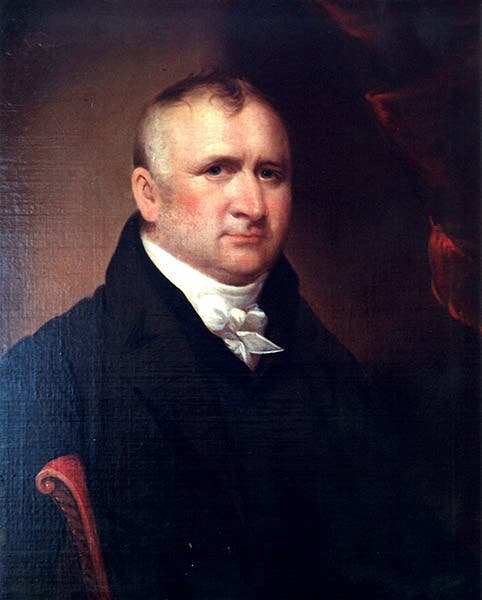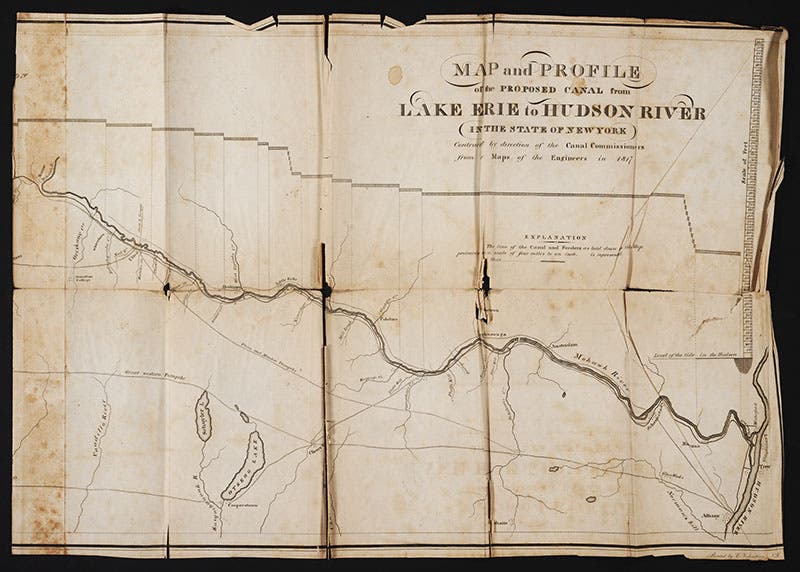Scientist of the Day - Benjamin Wright
Benjamin Wright, an American civil engineer, was born Oct. 10, 1770. Wright wasn’t just a civil engineer, he was the "Father of American Civil Engineering," or so says the American Society of Civil Engineers. He earned that title by being Chief Engineer of the United States' first grand engineering project, the Erie Canal, completed in 1825. Wright learned mostly on the job – there was no place to study civil engineering in the United States in the 1790s when Wright was in school – from an English canal builder, William Weston, who brought his craft to the States just as Western expansion made canal-building a high priority.
The Erie Canal opened for shipping on Oct. 26, 1825. The canal was built between 1817 and 1825, crossed 360 miles of upstate New York, from Lake Erie to the Hudson River, and dropped about 600 feet in elevation, requiring an unusually large (and expensive) number of locks, all designed by Wright. We show a map of the route of the completed canal, from an 1826 book on inland navigation in the United States (third image).
During the 8 years that Wright oversaw the digging of the Erie Canal, he in turn trained nearly every one of the next generation of civil engineers, men like Canvass White and Charles Ellet, Jr. The canal was a great success; it was once eloquently said of Wright and his crew: "They built the longest canal in the world, in the least time, with the least experience, for the least money, and the greatest public benefit." Most of the original canal has been enlarged or replaced, but many of Wright's constructions have been preserved as historic sites, such as the famous five-step lock at Lockport, now just a scenic sluice (fourth image)

Benjamin Wright’s five-flight locks preserved at Lockport, N.Y., at the right, with the modern replacement one-step lock at left (weebly.com)
The first boat to traverse the canal from Lake Erie carried New York state Governor DeWitt Clinton, who was the principal driving force behind the canal project. Clinton carried a barrel of Lake Erie water with him, and when the boat reached New York City on Nov. 4, there was a huge celebration, and a ritual "wedding of the waters" as the barrel was poured into the harbor. We have in the History of Science Collection the Official Report of the Canal Commissioners (1817), prepared at Clinton's request, which sets out the projected stages of construction, and contains an extended fold-out map of the proposed canal route, which in our copy is not in very good condition; we show a detached section of the eastern end of the proposed canal (fifth image). Our copy of the Report redeems itself because it was DeWitt Clinton's own copy, with his bookplate pasted inside and his name stamped in gold on the front cover (sixth image). It later passed to the Engineering Societies of New York, whence the book came to us in 1995, when we acquired that collection.
Our first image, depicting an Eric Canal lock, was taken from William Henry Bartlett’s splendid picture book: American scenery; or, land, lake, and river illustrations of transatlantic nature (1840). Bartlett was a Scientist of the Day himself last year, where we reproduced this engraving and several others.
Wright is buried in the New York Marble Cemetery, which, says this ASCE website, is “not to be confused with the nearby New York City Marble Cemetery.” I would say, rather, that it is almost certain to be confused with the New York City Marble Cemetery. Who allowed that to happen, one wonders.
Dr. William B. Ashworth, Jr., Consultant for the History of Science, Linda Hall Library and Associate Professor emeritus, Department of History, University of Missouri-Kansas City. Comments or corrections are welcome; please direct to ashworthw@umkc.edu.










